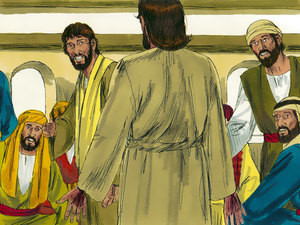
Jesus appears to his disciples.
Copyright: Free Bible Images
Peace be with you!
We are addicted to the ways and ideas of the world. We accept what the world says is possible and reject what is impossible. We accept the half-truths and the lies the world tells us. We try to meet the world’s standards by dressing and appearing certain ways in order to hide the scars and emotional baggage of our past. Addictions, such as drugs, alcohol, gambling, sex, or [whatever “it” is], further isolate us from others, relationally and even legally. When individuals are caught with illegal drugs in the United States, they are given a criminal record and are further isolated from society, sometimes for the rest of their lives.
In similar ways, we isolate ourselves from God when we give in to the addictions of world—power, wealth, fame, and [whatever “it” is] that separates us from God. In the United States, we focus on being individuals and standing on our own. We are addicted to thinking that we are okay and not broken, and we even tell God that we can do it on our own because that is what the world tells us. We struggle 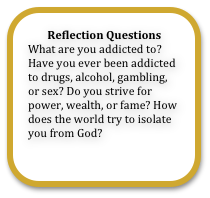 to build meaningful and lasting relationships. We struggle to create authentic communities that would have people who lift up our strengths and lament with us in our brokenness. We struggle to connect with a seemingly distant and unseen Lord.
to build meaningful and lasting relationships. We struggle to create authentic communities that would have people who lift up our strengths and lament with us in our brokenness. We struggle to connect with a seemingly distant and unseen Lord.
We struggle with the resurrection of Jesus Christ. The world tells us that death gets the last word—you are born, live, and die: the end. There is nothing beyond the grave, and when you study science, that makes sense. When plants die, we can watch them decompose and disappear, and therefore we believe it to be true.
After Mary Magdalene comes and tells the disciples she has seen the Lord, they barricade themselves in a room (John 20:18-19). In fear of the Jews, the disciples create a sense of security by closing and locking the windows and doors—no one should be able to go in or out. The disciples have legitimate reasons to fear the Jews; the Romans had just killed their Lord. Somehow, the Jewish leaders are now allies with the Roman leaders who will kill anyone who does not pledge their allegiance to the Roman Empire.[i] The disciples have pledged their allegiance to Jesus Christ, the Messiah. They followed him for three years until he was crucified. Now the disciples have to face the aftermath of Jesus dying: it is over, done, finished. There will be no more healings. Jesus will not tell any more parables. Despite Mary Magdalene’s report, the disciples are afraid of the aftermath.
We have all been where the disciples are right now. We have all hidden after something—a breakup, traumatic event, illegal activity, or [whatever “it” is]. Some of us run into our rooms, lock the door, and hide in the bed under the blankets. Others pack a bag and put 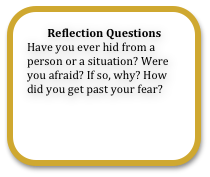 distance between the situation and themselves. Others turn to drugs or alcohol to escape reality, while others may just deny [whatever “it” is] ever happened. The disciples are hiding until they can figure out their next step.
distance between the situation and themselves. Others turn to drugs or alcohol to escape reality, while others may just deny [whatever “it” is] ever happened. The disciples are hiding until they can figure out their next step.
Then Jesus breaks into the locked-up room, greets the disciples (“Peace be with you”), and shows them his wounds (John 20:19-20). The disciples rejoice when they see the risen Lord (John 20:20). They finally get what Jesus meant when he said he would rise after three days and they rejoice that their dear friend who was dead is now alive. Jesus defeats the ways and ideas of the world and breaks into their and our lives. Jesus breaks the rules of the world in order to give us the opportunity to renew our relationship with God the Father. Jesus redefines what is possible.
However, Thomas, a disciple, is not present when Jesus breaks into the room and does not believe the others actually saw Jesus (John 20:24-25). Thomas says, “Listen boys, I have to see Jesus and touch his wounds for myself before I will believe this fairy tale you are telling me” (see John 20:25). We have all had friends who have told us crazy stories that we fell for. Maybe Thomas was known as the gullible one who would believe anything, but this time he is not falling for it. Maybe Thomas cannot get his mind wrapped around Jesus rising from the dead. Whatever the reason, Thomas has his doubts and asks the other disciples to prove it. For a week, the disciples try convincing Thomas that they are telling the truth, though he just does not believe them.
A week after Jesus’s first appearance, the disciples, including Thomas, are locked in the room, and just as they said, Jesus enters the room without opening any doors and says, “Peace be with you” (John 20:26). Then Jesus turns to Thomas and says, “Put your 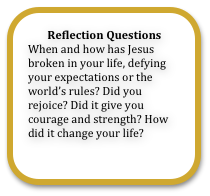 finger here and see my hands. Reach out your hand and put it in my side. Do not doubt but believe.” Then Thomas says, “My Lord and my God!” (John 20:27-28 NRSV). Thomas gets to see Jesus’s hands, feet, and side where he was nailed to the cross and stabbed. He gets up close and personal and sees Jesus’s wounds, and therefore, he believes.
finger here and see my hands. Reach out your hand and put it in my side. Do not doubt but believe.” Then Thomas says, “My Lord and my God!” (John 20:27-28 NRSV). Thomas gets to see Jesus’s hands, feet, and side where he was nailed to the cross and stabbed. He gets up close and personal and sees Jesus’s wounds, and therefore, he believes.
Thomas sees Jesus, his Lord and his God, within the context of the human condition—as a broken individual—and yet he overcomes the grave for our sake. In The Disabled God: Toward a Liberatory Theology of Disability, Nancy L. Eiesland writes, “The disabled God emerges in the particular situation in which people with disabilities and others who care [for them] find themselves as they try to live out their faith and to fulfill their calling to live ordinary lives of worth and dignity.”[ii] If people with disabilities are able to imagine God as being disabled, then they are able to see themselves in the image of God, which enforces the important truth that they are a part of God’s good creation. Thomas sees his God taking the form of a human, suffering greatly for his sins, and still claiming victory over the grave.
This is what makes the resurrection so powerful. Jesus conquers the grave but still has his scars. The disciples really could see and touch his wounds. When you deal with your own addictions—drugs, alcohol, Facebook games, gambling, shopping, food, or [whatever “it” is], you still have to fight daily urges and impulses. You still have the scars of your past decisions. You still have the memory and the guilt. However, here is the game changer: Jesus knows our pain and suffering and has the scars to prove it, yet he rises from the dead and ascends into heaven to God the Father. God is not trying to pull a fast one over on us; Jesus really did die on the cross. It was not a magic trick; Jesus really was not breathing in the tomb. Jesus did not have a stunt double; Jesus really did die and rise after three days.
In the same way, you fall and rise time after time again. You fall for the world’s lies, but then you realize the hard truth and you turn back to the Lord. You become addicted to drugs, alcohol, Facebook games, gambling, shopping, or [whatever “it” is], but then you realize it is hurting yourself and others and you turn back to the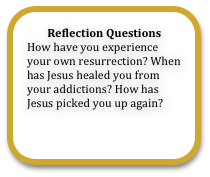 Lord. You submerge yourself in your brokenness—depression, anxiety, post-traumatic stress disorder, physical limitations or [whatever “it” is], but then you realize God loves you, despite your brokenness, and you turn back to the Lord. The power of the resurrection is that Jesus falls aside us, and he picks us up time after time again!
Lord. You submerge yourself in your brokenness—depression, anxiety, post-traumatic stress disorder, physical limitations or [whatever “it” is], but then you realize God loves you, despite your brokenness, and you turn back to the Lord. The power of the resurrection is that Jesus falls aside us, and he picks us up time after time again!
Thanks be to God!
Dear Heavenly Father, thank you for conquering the grave through Jesus’s crucifixion, death, and resurrection. Help us to turn away from the world’s lies and addictions. Lift us up from our brokenness into your loving arms. Reveal the power of the resurrection through our actions. Thank you for coming alongside us and picking us up, time after time. Amen.
[i] Craig S. Keener, The Gospel of John: A Commentary, 2 vols. (Peabody, MA: Hendrickson, 2005), 1200.
[ii] Nancy L. Eiesland, The Disabled God: Toward a Liberatory Theology of Disability (Nashville: Abingdon Press, 1994), 98.